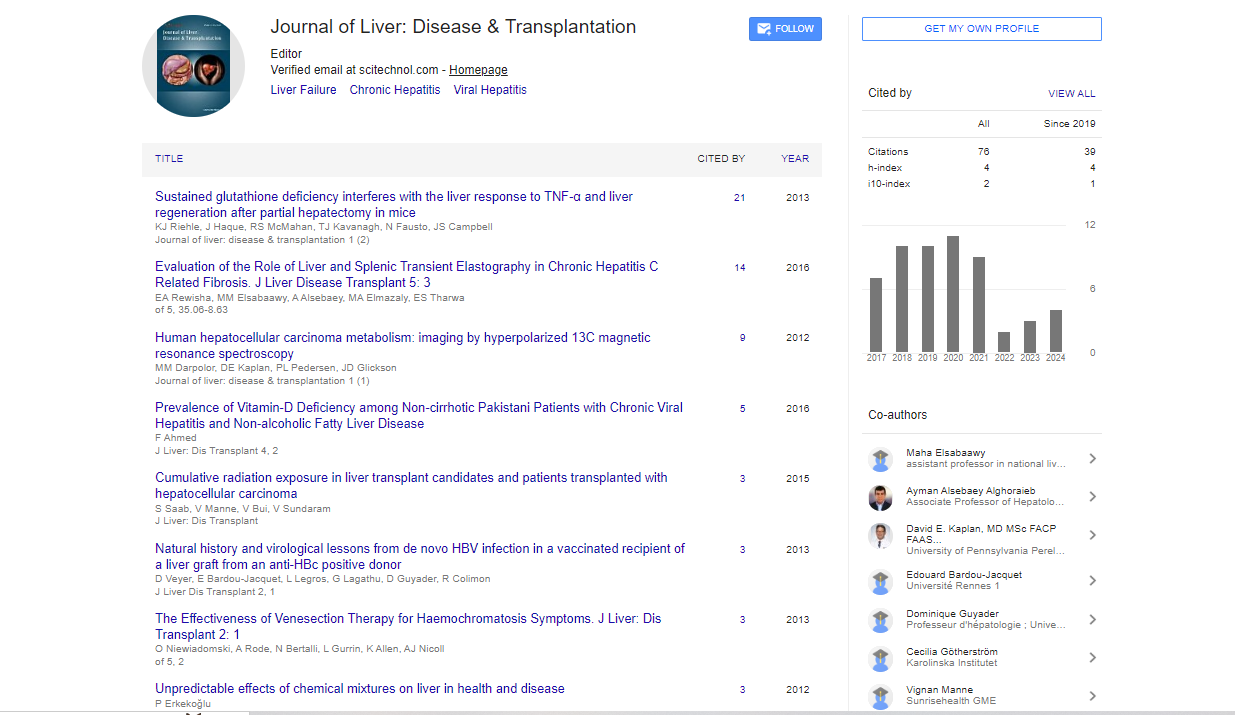Perspective, J Liver Disease Transplant Vol: 13 Issue: 4
Mechanisms of Drug Metabolism in Liver Disease: Implications for Therapeutic Development
Victor Cossiga*
1Department of Liver and Pancreas Transplantation, David Geffen School of Medicine at UCLA, Los Angeles, United States of America
*Corresponding Author: Victor Cossiga,
Department of Liver and Pancreas
Transplantation, David Geffen School of Medicine at UCLA, Los Angeles, United
States of America
E-mail: vc@dcsm.edu
Received date: 28 November, 2024 Manuscript No. JLDT-24-156903;
Editor assigned date: 02 December, 2024, PreQC No. JLDT-24-156903 (PQ);
Reviewed date: 16 December, 2024, QC No. JLDT-24-156903;
Revised date: 23 December, 2024, Manuscript No. JLDT-24-156903 (R);
Published date: 30 December, 2024, DOI: 10.4172/2325-9612.1000286.
Citation: Cossiga V (2024) Mechanisms of Drug Metabolism in Liver Disease: Implications for Therapeutic Development. J Liver Disease Transplant 13:4.
Abstract
Description
Drug metabolism in liver disease is not only affected by enzyme activity and hepatic blood flow but also by the interaction between various other physiological and pathological factors. One of the key contributors to altered drug metabolism in liver disease is the altered expression and function of liver enzymes, particularly those from the Cytochrome P450 (CYP) family and phase II conjugation enzymes. For example, the reduced activity of enzymes like CYP3A4, CYP2C9 can lead to slower drug clearance and prolonged drug half-lives resulting in the accumulation of drugs and their potentially toxic metabolites. This reduced enzymatic activity often correlates with worsening liver disease severity, as seen in conditions such as cirrhosis, where liver damage impairs enzyme function. Moreover, phase II metabolic pathways, such as glucuronidation, sulfation and conjugation with glutathione, also plays an important role in drug metabolism. In liver disease, the activity of these pathways tends to decrease, leading to reduced capacity for metabolizing and detoxifying drug metabolites. This can result in increased concentrations of unmetabolized or partially metabolized drugs, further exacerbating the risk of drug toxicity.
Another important factor contributing to altered drug metabolism in liver disease is the altered distribution of body fluids and proteins. Liver dysfunction often results in changes in plasma protein levels, particularly albumin, which is responsible for drug binding. Reduced albumin levels in liver disease can lead to higher free (active) drug concentrations, as more of the drug remains unbound in circulation. This increased free drug concentration can enhance the drug's pharmacologic effect, intensifying both therapeutic and toxic responses. The impact of liver disease on drug metabolism extends beyond enzyme activity and protein binding to include changes in hepatic transport systems. Hepatic transporters such as the Multidrug Resistance-associated Proteins (MRPs) and Organic Anion- Transporting Polypeptides (OATPs) are essential for the uptake and clearance of various drugs. In liver disease, the expression and function of these transporters may be reduced or altered, further impeding drug elimination and increasing drug accumulation in the liver and systemic circulation.
These metabolic alterations emphasizes the need for careful consideration of dosing strategies in patients with liver disease. Standard dosing regimens may no longer be suitable due to these pharmacokinetic changes. Drug therapies often require dose adjustments based on the severity of liver dysfunction, as assessed by models such as the Child-Pugh score or the MELD score, which provide an estimate of liver function and guide drug dosing decisions. Personalized medicine approaches have become increasingly important in managing drug therapy for patients with liver disease. Pharmacogenomic factors, including genetic polymorphisms in drugmetabolizing enzymes like CYP2C9, CYP2D6 and UGTs, can influence drug metabolism and patient response. For example, patients with specific genetic variations may metabolize drugs at different rates, necessitating individualized dosing regimens to avoid drug toxicity or suboptimal drug efficacy. Additionally, the development of novel therapies targeting liver disease-related metabolic alterations has significant therapeutic implications. Drug developers are increasingly focusing on designing drugs that are less dependent on liver metabolism or are more resistant to changes in liver function. Prodrugs, for instance, are designed to be inactive until metabolized by specific enzymes, thus minimizing the impact of liver dysfunction on their activation. Drug formulations that bypass hepatic metabolism, such as those utilizing alternative routes like intravenous administration, also shows assurance in overcoming drug metabolism challenges in liver disease.
Conclusion
Drug metabolism in liver disease is deeply affected by altered liver enzyme activity, reduced hepatic blood flow, changes in protein binding and altered drug transport mechanisms. These disruptions lead to pharmacokinetic challenges, including increased drug accumulation, prolonged drug half-lives and the potential for drug toxicity. Understanding these mechanisms is essential for optimizing drug dosing regimens and advancing personalized medicine approaches. The continued analysis of pharmacogenomic factors and the development of therapies that minimize dependence on hepatic metabolism hold significant potential for improving drug therapy outcomes in patients with liver disease.
 Spanish
Spanish  Chinese
Chinese  Russian
Russian  German
German  French
French  Japanese
Japanese  Portuguese
Portuguese  Hindi
Hindi 